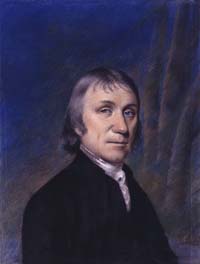
| Born: Mar 24 [O.S. Mar 13], 1733 in Birstall, West Riding of Yorkshire |
| Died: Feb 6, 1804 (at age 70) |
| Nationality: English |
| Famous For: Invention of soda water, writings about electricty, discovery of gases (“airs”) |
Joseph Priestley is best known for isolating and discovering oxygen, along with several other gases. He was a leading contemporary thinker and covered a lot of areas other than chemistry. This included electricity, magnetism, physics and optics. Earlier in his lifetime he had a considerable reputation for his writings on electricity and for discovering soda water. Priestly was a defender of the Phlogiston theory and was left isolated by the scientific community because he chose to reject what later became the chemical revolution.
Early Life
Priestly was born into a family that was known for being Dissenters. This meant that they did not conform to the Church of England. He studied in a local grammar school and was regarded as a brilliant student. Priestly excelled in most subjects, including physical sciences. His ill health forced him to return home from school after three years of studying. After his health improved he went on to study history, science and philosophy at Daventry Academy. Here, he read a book entitled Observations of Man, which was written by David Hartley. This book influenced his work and was the reason why he worked to further his education.
Discovery of Oxygen
In 1774, Priestly conducted an experiment which allowed him to isolate an air that was not yet studied. He was not able to completely study this new discovery because of his travels. Priestly repeated the experiment several times during that year. It was not until January of the following year when Priestly continued his experiments that he discovered “vitriolic acid air,” which is now known as Sulfer Dioxide. He replicated the experiment in front of other chemists, including the French chemist Antoine Lavoisier, who is known as the “father of modern chemistry.”
During the month of March, 1775, Priestly wrote to several people about his discovery of the new air he observed the previous year. His letters were read aloud during a meeting among the Royal Society. This was outlined in a paper that was entitled “An Account of Further Discoveries in Air.” He conducted several experiments with this new air using mice. He concluded that the mice were able to last longer in a tight-sealed container with this air. He believed that this air was superior to common atmospheric air. His discovery was later known as Oxygen gas. He later assembled a paper on his account of this gas which was published in 1776.
Chemical Revolution
Priestly was a firm believer in the Phlogiston theory, which is an obsolete scientific theory. It states that there is a fire-like element that was called “phlogiston” which is responsible for combustion and the rusting of metals. Although this theory was regarded as more of a principle during the 18th Century, Priestly was known to be one of the few who still used the term in his experiments. The chemical revolution was influenced by some of his experiments as well as those conducted by other scientists. The revolution did away with the theory of phlogiston, yet Priestly still rejected the new principles.